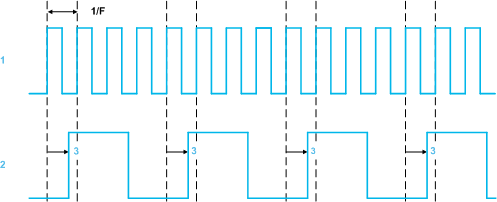The module enables signal comparisons between one channel and the concurrent channel in the module. Each input channel gives ratio and angle values calculated with the concurrent input channel and reciprocally.
Ratio and angle values are provided together at the rate of the concurrent channel, with a maximum of 10 measures per second.
Dedicated validity bits for both ratio and angle values are provided in the variable
COUNTER_STATUS (
%IW.r.m.c.0). In addition, after the ratio or the angle measure done an
event can be generated.
Neither configuration nor programming is required to provide the ratio and angle. However the function provides ratio and angle values related to one channel as long as the input frequency on the concurrent channel does not exceed what received on this channel.
Ratio gives the number of received pulses on one channel within two pulses received on the concurrent channel. An example is given below:
1
Channel input
2
Concurrent channel input
In the typical use case:
-
The dual channel function is to calculate mechanical ratio between gears,
-
The ratio remains stable for one application,
-
The concurrent channel receives a signal from metal detection of the crank of machinery while the channel input receives a signal from speed detection of a gear.
Hence, the ratio value gives the number of teeth for one gear revolution.
In an application trying to measure ratio greater than 65535, the module provides unexpected values.
Angle is given by the time delay between the last received pulse on one input channel and the pulse on the concurrent input channel. An example is given below:
1
Channel input
2
Concurrent channel input
3
Time delay
Angle value is calculated according to the formula: Time delay = Angle x 0.5 μs
In the typical use cases:
-
The pulse ratio (between gears) is regular,
-
The velocity is stable when the application considers the angle value.
Hence, the application can retrieve the mechanical angle between gears on assessing the angle value versus the input signal period (1/F).
In other application, the value can report the phase angle between two same frequencies (for example 50/60 Hz)
The Angle value is calculated for input signal frequency greater than 40 Hz. For input signal frequency less than 40 Hz, the Angle value is forced to 65535.

 WARNING
WARNING 